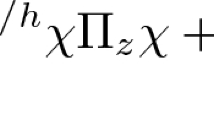Abstract
We propose a contribution to the theory of quantum resonances that combines complex absorbing potentials (CAP) with standard perturbation theory. We start from resolvents that depend on two variables, the complex energy z and a perturbation parameter \(\lambda\). The wave functions and the energies of the resonances are expanded in powers of \(\lambda\). It is shown that the zero-order terms correspond to the standard CAP method and that higher-order corrections are significant. The introduction of a convergence operator allows to control the convergence of the perturbation series. Due to the discretization of the continuum, the series are generally asymptotic. Finally, we relate the perturbation series to numerically convenient Taylor series. The theory is illustrated on two model examples.






Similar content being viewed by others
References
Feshbach H (1958) Ann Phys 5:357–390
Feshbach H (1962) Ann Phys 19:287–313
Kukulin VI, Krasnopol’sky VM, Horáček J (1989) Theory of resonances principles and applications. Academia, Praha
Moiseyev N (2011) Non-hermitian quantum mechanics. Cambridge University Press, Cambridge
Jolicard G, Austin E (1985) Chem Phys Lett 121:106–110
Riss UV, Meyer H-D (1993) J Phys B At Mol Opt Phys 26:4503–4536
Muga J, Palao J, Navarro B, Egusquiza I (2004) Phys Rep 395:357–426
Durand P, Paidarová I (1996) C R Acad Sci Paris IIb 322:555–562
Durand P, Paidarová I (1997) Czech J Phys 47:657–665
Gemperle F, Gadea FX, Durand P (1998) Chem Phys Lett 291:517–522
Paidarová I, Durand P (2010) In: Nicolaides C, Brändas E (eds) Unstable states in the continuous spectra I: analysis, concepts, methods, and results, vol 60. Elsevier Academic Press, Sant Diego, pp 1–49. Advances in Quantum Chemistry
Durand P, Paidarová I (2013) J Phys B At Mol Opt Phys 46:075001
Jagau TC, Krylov AI (2014) J Phys Chem Lett 5:3078–3085
Mera H, Pedersen TG, Nikolic BK (2015) Phys Rev Lett 115:143001
Cohen-Tannoudji C, Dupont-Roc J, Grynberg G (1988) Processus d’interaction entre photons et atomes, InterEditions et Editions du CNRS, English translation: (1992) Atom-Photon Interactions. Basic Processes and Applications. J. Wiley,
Fano U (1935) Nuovo Cimento 12:154–161
Fano U (1961) Phys Rev 124:1866–1878
Bain R, Bardsley J, Junker B, Sukumar C (1974) J Phys B At Mol Opt Phys 7:2189–2202
Durand P (1983) Phys Rev A 28:3184–3192
Durand P, Paidarová I (1998) Phys Rev A 58:1867–1878
Ehara M, Sommerfeld T (2012) Chem Phys Lett 537:107–112
Sommerfeld T, Ehara M (2015) J Chem Phys 142:034105
Acknowledgments
The authors thank Roman Čurík for helpful discussions and comments.
Author information
Authors and Affiliations
Corresponding author
Appendix: Perturbative development of the resolvent
Appendix: Perturbative development of the resolvent
Let H be the Hamiltonian of a quantum system and \({\widehat{R}}\) the resolvent in the complementary space (see (5))
It is useful to write \({\widehat{R}}\) in the form
In this article, we chose
\(H(\lambda )\) is the complex (non-Hermitian) Hamiltonian of the complex absorbing method. \(-\imath \,\lambda \,{\hat{\epsilon }}\) is a complex absorbing potential (CAP) which is introduced for computational reasons. It is a mathematical device that smooths the eigensolutions of H in the continuum when one uses finite basis sets. For investigating the quantum resonances through Green’s functions, one has to face the problem of the incompleteness of the basis sets for describing the continua. This is the main and crucial role devoted to \({\hat{\epsilon }}\). More precisely, \({\hat{\epsilon }}\) has to produce square-integrable functions tailored at convenience.
The expansion
introduced in (26) provides the perturbative expansion of \({\widehat{R}}\):
The first three terms of the expansion are
The above expansion is formally a standard perturbation series, but because \(\lambda\) appears also in the denominator of \({\widehat{R}}^{(0)}(\lambda )\), the terms in (30) have the structure of Padé approximants. Nevertheless, in the following, we keep the usual vocabulary of perturbation theory. For practical applications, it is convenient to express the quantities \({\widehat{R}}^{(1)}\), \({\widehat{R}}^{(2)}\), \({\widehat{R}}^{(3)},\ldots\) in terms of the derivatives of \({\widehat{R}}^{(0)}\) with respect to \(\lambda\):
It can be checked that the expression (31) is true for \(k=1\) and \(k=2\). Its validity for any value of k is proved by recurrence:
The derivative of \({\widehat{R}}^{(k)}\) defined in (29) with respect to \(\lambda\) gives
It can be checked that the two expressions
are true. Introducing (33) in (32) leads to the recurrence relation
Finally, introducing (31) in the right-hand side of (34) leads to
The comparison between (31) and (35) demonstrates that if (31) is true for k, it also holds for \(k+1\). The recurrence is proven because (31) is true for \(k=1\).
Inside the main text of this article, we consider Green’s functions derived from the reduced resolvent. From (9), (29) provides the expansion of the self-energy
The zero-order term reads
and
Note that if the expansion (36) is finite, R(z) becomes dependent on \(\lambda\).
Rights and permissions
About this article
Cite this article
Durand, P., Paidarová, I. Perturbation theory of quantum resonances. Theor Chem Acc 135, 159 (2016). https://doi.org/10.1007/s00214-016-1912-y
Received:
Accepted:
Published:
DOI: https://doi.org/10.1007/s00214-016-1912-y



